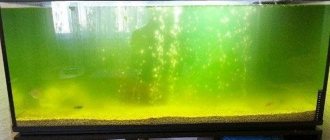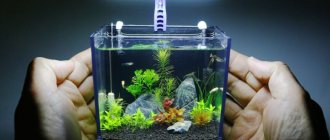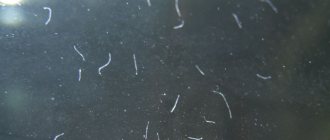An aquarium with fish and green flowers, no matter where it is located, always attracts the attention of others. However, you can enjoy the underwater spectacle if the water in the tank is clean and transparent, but green and cloudy water is not a pleasant sight. Even inexperienced aquarists know that blooming water in an aquarium is an alarming signal for a fish owner. In order not to endanger the inhabitants of the tank, every aquarist should know why the water in the aquarium turns green and how to deal with it.
Why is this problem dangerous?
Green water itself is not dangerous for fish, but its causes can cause irreparable harm.
In addition, due to a lack of lighting, the photosynthesis process in plants slows down, they do not release oxygen, which is so important for the respiration of fish, shrimp and even beneficial bacteria.
Therefore, it is so important to use enhanced aeration during this period.
Also dangerous are dead parts of plants that begin to rot, thereby filling the aquarium water with organic compounds and further aggravating the situation. It is not advisable to feed the fish during this period; they, of course, will not die of hunger, but it will cause them some discomfort.
Biological balance is the key to purity
Achieving complete biological balance in an artificial reservoir is difficult, but possible. Normally, in a reservoir, like in a large natural lake, the cycle of substances must be observed. All dead remains must be broken down by beneficial bacteria and reduced to substances that can be consumed by plants, then produce energy through photosynthesis and again produce biological matter - most often starch and polysaccharides. Next, the fish eat plants, digest the organic matter of their relatives, if they are predators, build their body from amino acids, produce waste, and the process begins again.
Nitrifying bacteria are responsible for this balance. When they die, dangerous processes can move up the food chain: the death of one group of microorganisms can cause disease and death of fish. In nature, everything is harmonious, so the balance is established by itself, our task is just not to disturb it inadvertently or intentionally: do not use chemicals, chlorinated water, fertilizers and other artificial preparations.
What to do and how to deal with this?
Aquarists know many folk methods that will help get rid of this scourge, but in especially advanced cases, they cannot do without the use of chemicals.
Traditional methods
Traditional methods only help if the aquarist began using them as soon as he discovered the problem.
In neglected aquariums they are ineffective:
Complete shading of the aquarium.
Algae are not able to reproduce without light, but it is necessary to shade it for at least a few days, which will also cause damage to aquarium plants. The lighting equipment is not turned on, the aquarium is covered with a cloth that does not allow light to pass through, and enhanced aeration is activated.- Using a micron filter attachment . Regular sponges are not able to filter out algae, and the micron nozzle has such small pores that it traps spores, but such a nozzle will have to be regularly replaced with a new one.
- Using padding polyester as a filler for filter equipment. Sintepon can also trap algae, but it is not as effective as a micron filter.
- Using an ultraviolet sterilizer is not exactly a traditional method, but it is the most effective among those that do not use chemicals. The sterilizer guarantees clear water for several days. The remaining methods are used for no more than 3-4 days, and if there is no result, or the situation worsens, then you should move on to more serious methods.
Chemical methods
The use of chemicals is guaranteed to produce results, but it also undermines the biological balance in the aquarium.
It is worth using chemistry only after all alternative methods have been tried and found to be ineffective:
- Bicillin - 5 . A broad spectrum antibiotic kills algae in one day. But in addition to algae, all beneficial bacteria die, so an outbreak of ammonia/ammonium and nitrite is a matter of time.
Sidex and its analogues. Glutaraldehyde, known to any aquarist, is used in increased dosage.
It is also effective, but has a number of consequences: it burns plant leaves, provokes pH fluctuations, has a poisonous effect on aquarium shrimp and can kill some fish.Regular addition of glutaraldehyde in small doses will be an excellent prevention of green water in the aquarium.
- Hydrogen peroxide . The most common 3% pharmacy peroxide in large dosages can quickly oxidize all algae and make the water clear, while some types of plants absolutely cannot tolerate the addition of peroxide, and fish can get oxygen poisoning.
After using aquarium chemistry, additional measures will definitely be required: the use of activated carbon, increased substitutions and the artificial introduction of bacterial cultures.
Preventive actions
After cleaning using one of the listed methods, you will need to take preventive measures to maintain a normal microclimate in the aquarium. This is necessary to prevent the water from blooming. This is not difficult to achieve; it is enough to follow simple recommendations: install the container so that it is not exposed to direct sunlight; when laying the soil, place the contents at an angle, placing a denser layer of pebbles towards the front wall of the tank; adjust the backlight power at the rate of 0.5 W per 1 liter of content; periodically turn off the lighting, and algae will not grow as actively (many types of underwater plants can do without artificial light for 5-7 days in a row); cover the tank with a lid to prevent particles of dust, insects and debris from entering the water; control the operation of aquarium equipment; Regularly clean the container, decorative elements and replace the water.
These steps do not eliminate the need to periodically replace the contents of the aquarium, but they will help curb bacterial growth and prevent the water from becoming cloudy and green too quickly. Like any pets, fish require proper care and maintenance of cleanliness in their habitats. The peculiarity of underwater inhabitants is that they spend their entire lives in one container, and for their comfortable existence you will need to carefully monitor the microclimate of the underwater world. Otherwise, the inhabitants of the artificial reservoir will get sick and die prematurely.
Why is this happening?
It is quite easy to make water clear using antibiotics and other chemicals, but if you do not find and eliminate the cause of its greenness, this will only give a temporary effect. And there may be several reasons for this phenomenon.
Bad light
If the light is too low, plants cannot fully absorb nutrients, they begin to wither, and some plants die and rot.
This contributes to an increase in the level of nitrates, which are not consumed by higher vegetation, but actively contribute to the proliferation of algae, which gives the water a green tint.
Increased lighting accelerates the consumption of nutrients, and if they are not added additionally in the form of fertilizers and the water is not enriched with carbon dioxide, then the plants eat up the available nitrates and phosphates very quickly and begin to starve.
This is what algae take advantage of, because their development requires a minimum amount of nitrogen compounds.
How to fight:
- Darken the aquarium for several days.
- Set up lighting equipment.
- If the lighting is too powerful, then after treatment, start adding fertilizers and CO2.
Contaminated tank
This problem often appears in aquariums where its owner neglects the rules of caring for his underwater world: does not remove rotten parts of plants, does not siphon the soil, does not change the water once a week.
The accumulation of waste from the inhabitants is an excellent impetus for the growth of algae in the water column.
What to do:
- Make a massive change with a soil siphon, this will reduce food for algae.
- Darken the aquarium or use chemicals.
- Don’t forget to take care of the aquarium and make a clear replacement schedule.
Low quality feed
Often the water turns green due to low-quality food, especially if the aquarist has a habit of overfeeding his pets. Uneaten food begins to rot, decompose and release many chemical elements into the water, which provoke the appearance of algae.
Ways to fight:
- Use only high-quality dry food from well-known manufacturers.
- Avoid using live or frozen food.
- Do not overfeed the fish.
This often happens when feeding cheap supposedly “plant foods” - green flakes.
In fact, these can be ordinary flakes colored with green food coloring, and, as a result, the water instantly takes on a green tint.
Poor filtration
If the aquarium has a filter whose power is not designed for the volume of a particular aquarium, this can easily provoke an algae outbreak. The volume of filter material is not able to provide normal filtration, so the water is actively polluted.
What to do:
- Use a filter that is designed for a specific volume.
- In large aquariums, prefer external filters.
- Don't forget to maintain your filter equipment.
- Use fine-pored fillers that will remove algae.
Overcrowding or lack of volume
A densely populated aquarium is most often subject to the problem of greening. This is due to the fact that fish produce more waste than bacteria can process.
Also, you should not keep large fish in small volumes; in addition to the fact that the fish will be uncomfortable, they will quickly pollute it.
How to proceed:
- For the first time, increase aeration.
- Give away or sell extra fish.
- Keep only fish that are suitable for the selected volumes.
Excess of organic matter
An excess of organic components is the main reason for green water; organic matter simply appears in different ways.
Most often, organic waste (fish feces, dead parts of plants, uncollected corpses of inhabitants) accumulates on the ground and begins to rot. Therefore, they need to be removed on time.
An excess of organic matter always indicates an imbalance in the aquarium - either insufficient care, or overfeeding, or overcrowding.
What to do:
- Make changes little by little every other day, while siphoning the soil.
- Remove all dead leaves and make sure there are no dead inhabitants.
- Rinse the filter.
- Increase aeration.
How to get rid of green deposits in an aquarium
Before you find out how to completely remove green plaque, you should determine the cause of the development of algae and eliminate it, otherwise the fight will be pointless. After the unfavorable factor has been eliminated, you need to prepare the following tools to get rid of plaque:
- A scraper with a blade is needed to clean glass.
- An old bucket or basin with a capacity of more than 10 liters.
- Water to replace fluid in the aquarium.
- Siphon type pump.
- Baking soda/wine vinegar to remove dirt and bacteria.
- Bleach solution 10%.
How to clean an aquarium and get rid of green deposits:
- First you need to remove the greenery from the walls of the aquarium, having previously moved the fish into a separate pond, and using a scraper with a blade. The water from the tank is not drained. For convenience, it is better to use a magnetic scraper.
- Dirty water is pumped out of the aquarium using a pump: one hose is immersed in the tank, the second in an old bucket.
- After draining the water, begin cleaning the internal elements. Decorations and decorations are removed from the container and set aside - they should be dealt with later. After this, they pass the pump over the stones, pulling out dirt and algae, and over the ground. If sand or gravel is used as a substrate, loosen the soil by hand and apply it with a hose at a distance of 2.5 cm from the bottom. This will prevent the substrate from being drawn into the hose.
- Removed jewelry and decorative elements are cleaned of plaque manually. If the level of contamination is high, then use bleach - the elements are immersed in the solution for 15-20 minutes and then scalded with boiling water.
- Pre-settled clean water is poured into the washed tank, and the indicators are measured: temperature, hardness, acidity. If the parameters are normal, you should wait a couple of hours for the particles in the water to settle to the bottom and the liquid to become clear.
- The last step is to clean the outside of the aquarium, using soda or wine vinegar as cleaning agents. To clean, you need to moisten a clean rag or sponge with the product and carefully wipe the surfaces of the tank and devices.
What causes rapid greening and how does it differ from gradual greening?
Gradual greening is a consequence of problems in the aquarium. It is provoked by the accumulation of a large number of organic elements.
The water changes color due to certain types of algae that are found in absolutely any aquarium. It’s just that in a healthy tank they are not allowed to develop higher plants; they lack nutrition.
But sudden greening is also possible, which turns the water the color of a swamp within just a few hours. This happens most often in the summer, when aquarists use tap water during water changes, and with it these same algae, which grow well in natural reservoirs.
Signs
Signs of ecosystem disturbance:
- cloudiness of water;
- change in color of the liquid to green and brown;
- the scenery, water surface and soil are covered with a green film or coating;
- increased content of phosphorus and nitrates;
- abundant appearance of green plaque in the aquarium.
Plaque in small quantities is considered normal. Don't be alarmed if you notice a few green dots in your aquarium. Observe the flora; if the glass becomes more green and the water becomes cloudy, this should be a cause for concern.
Preventing the problem from recurring
To do this, simply follow the following recommendations:
Regularly care for the aquarium - water changes, soil siphoning, filter maintenance.- Use only high quality feed.
- Use glutaraldehyde (glutaraldehyde) in a prophylactic dosage.
- Do not overfeed the inhabitants.
- Ensure healthy growth of higher plants - apply fertilizers, normalize lighting.
- Don't create overpopulation.
- Have green water control products at the ready at all times.
- In the summer, it is better to use bottled or osmotic water for changes, but not from the tap.
If you follow all the recommendations, the likelihood of reappearance of algae in the water column will be minimal.
Causes
The appearance of plaque is caused by improper maintenance of the aquarium and disruption of its biological environment. Algae that creates a green coating on the walls of the aquarium:
- green euglena;
- xenococus;
- filament of oedogonium.
Thermal mode
Elevated temperatures have a beneficial effect on the development of weeds. Make sure that the lamp does not heat the water too much, and in the warm season, be especially attentive to the temperature regime.
In warm water, oxygen spreads less well, chemical reactions proceed faster, stimulating the release of nitrates into the water. These substances provide food for green weeds.
Light mode
Avoid direct sunlight on the walls of the vessel. The amount and spectrum of light plays a role. In summer, daylight hours do not exceed 12 hours, in winter – 7. The walls of the aquarium turn green from the intense light of the yellow spectrum.
Large amount of feed
The food that is not removed from the bottom becomes food for the lower greens. Remove excess feed with a siphon or net.
Human waste
Together with uneaten food, waste products create conditions for the proliferation of green algae and poison the water with ammonia and nitrates.











